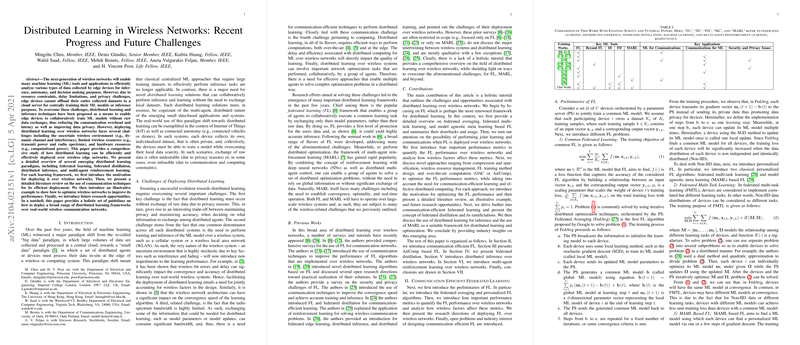Distributed Learning in Wireless Networks: Recent Progress and Future Challenges
The paper in question provides a comprehensive analysis of distributed ML methodologies as applied in wireless networks. The exploration involves a detailed paper of how such AI frameworks, including federated learning, federated distillation, distributed inference, and multi-agent reinforcement learning (MARL), are tailored for deployment in complex wireless environments. This synthesis addresses resource limitations, communication latencies, and privacy concerns inherent to edge networks.
Federated Learning (FL)
Federated learning is a paradigm where edge devices collaborate to train a shared model without exchanging raw data. The paper begins by delineating FL methodologies such as federated averaging, personalized FL through federated multi-task learning, and model agnostic meta learning-based FL. Of particular note is the handling of non-IID data, where techniques like federated multi-task learning and MAML become crucial.
From a wireless perspective, the paper identifies critical FL performance metrics, including training loss, convergence time, energy consumption, and reliability. Wireless constraints, such as spectrum allocation and device computational capacity, are shown to impact these metrics significantly. The interplay of these factors is meticulously analyzed, revealing complex trade-offs vital for optimizing FL over wireless networks.
Communication Efficiencies and Over-the-Air Computation
The research brings attention to the inherent communication bottlenecks faced in FL, especially with high-dimensional models. It reviews sparsification and quantization as compression strategies but appropriately recognizes their limitations. Hence, the paper explores Over-the-Air Computation (OAC) as a pivotal solution that harnesses waveform superposition to aggregate model updates, thus scaling efficiently with an increase in devices.
Federated Distillation (FD)
As an auxiliary to FL, Federated Distillation emerges as a less resource-intensive approach. By exchanging model outputs rather than parameters, FD significantly reduces communication payload, emphasizing this trade-off in terms of efficiency vs. model accuracy. Particularly under non-IID conditions, this approach promises efficiency improvements while maintaining acceptable performance levels.
Distributed Inference
Distributed Inference over wireless networks is identified as a critical component, aside from model training. The challenges here are shaped by the computational and memory constraints of edge devices and the necessity of rapid inference. The paper discusses neural network compression, where techniques such as pruning and quantization are applied to manage these resource demands. Combining device-based inference with edge server computations underlines a cooperative model that balances local processing with centralized capabilities.
Multi-Agent Reinforcement Learning (MARL)
The use of MARL for dynamic resource allocation and network control is dissected, presenting independent versus collaborative interaction models among devices. The paper elaborates on the convergence complexities, particularly in collaborative MARL where the convergence guarantees are subject to inter-agent information exchanges. Examples within UAV trajectory design highlight the practical applications and resulting improvements in system performance metrics.
Research Implications and Future Directions
The paper posits several open challenges, notably in convergence analysis, resource management, and algorithm design specific to distributed learning contexts. The theoretical underpinnings call for further integration with advanced wireless technologies and novel coding schemes to bolster efficiency and reliability. The discussion touches on industrial interest, yet the depth of analysis provides a formidable foundation for fostering ongoing academic inquiry.
In summary, the paper elucidates the formidable potential and existing challenges of deploying distributed learning frameworks in wireless networks. Insights into FL, OAC, FD, and MARL offer a roadmap not only for dealing with current system limitations but also for exploring avenues for future innovations in AI-driven wireless communications.
